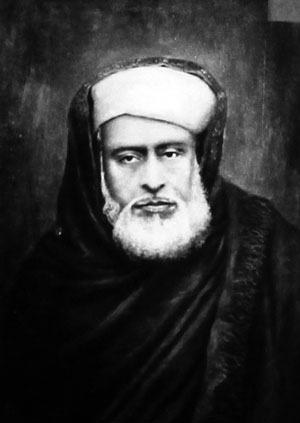maestros

Behram Khan
? - ca. 1880
Son of Gopal Das (Imam Baksh) Behram Khan is credited with giving the Dagar tradition its present shastra based form and developing its elaborate system of pedagogy that focuses on a long initial period of technical training through exercises. He travelled to Benares in his youth to learn music and its shastra from Kalidas Dagur, who accepted him as his disciple after subjecting him to many tests, and trained him to be an outstanding musician and a scholar.
He later served in various royal courts in Lahore, Alwar, Delhi, Suket Mandi and Jaipur and achieved renown as a great teacher receiving many rewards and titles from his patrons. It is said that he owned an elephant, and would ride on it whenever he visited his patron Maharaja Savai Ram Singh of Jaipur. He was renowned as a great scholar, and trained many students including his sons Saddu Khan and Akbar Khan, his grandson Inayat Khan and several nephews. The famed veena player Bande Ali Khan was son of his siister Gule Ahmad and is said to have also trained under him. His nephew Mohammad Jan Khan - son of his elder brother Hyder Khan. was one of his exceptional students and is said to have had a beautiful voice and to have shown great promise, but left home after a disagreement with Baba Behram Khan at a public performance.
A repentant Behram Khan then took up the task of teaching Mohammad Jan Khan's sons Zakiruddin and Allabande Khan who became the most effectve and renowned dhrupad singers of their generation.. Behram Khan had many disciples outside his family and trained many Khayal singers too. The founders of the Patiala gharana Aliya and Fattu are reported to have initially trained under him. and his student Gokibai. He is credited with developing the elaborate, methodical, grammar bound system of alap of the Dagars.
(photo of portrait of Behram Khan courtesy Jayanta Nath Ghose, Pathuriaghata, Kolkata)
For more on Behram Khan including probably his only extant photograph with other musicians of the Jaipur Gunijankhana see book Dhrupad of the Dagars, Conceptual Foundations and Contemporary Questions
- Zakiruddin Khan
- Allabande Khan
- Ziauddin Khan
- Nasiruddin Khan
- Rahimuddin Dagar
- Imamuddin Khan
- Hussainuddin Dagar
- Nasir Moinuddin Dagar
- Nasir Aminuddin Dagar
- Zia Mohiuddin Dagar
- Rahim Fahimuddin Dagar
- Nasir Zahiruddin & Nasir Faiyazuddin Dagar
- Zia Fariduddin Dagar
- Hussain Sayeeduddin Dagar
- Dagar Brothers